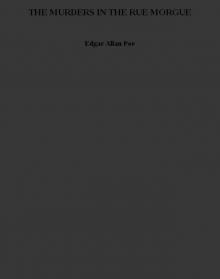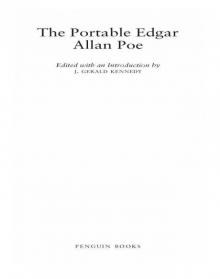- Home
- Edgar Allan Poe
Selected Tales (Oxford World's Classics) Page 3
Selected Tales (Oxford World's Classics) Read online
Page 3
In the even more ambiguous comic tale ‘The System of Doctor Tarr and Professor Fether’, the desire to know the mind is literalized as a visit to a French insane asylum. As with Delano’s racism in ‘Benito Cereno’, the narrator’s assumptions about the nature of madness prevent him from realizing that madmen are running the asylum. Poe’s tale, however, goes further to question not only the origins of and cures for madness, but the very project of ‘seeing’ sanity. The French historian Michel Foucault has shown how the asylum reforms of Phillipe Pinel and William Tuke attempted to ‘master’ unreason. So, in Poe’s tale, the very idea of visiting the insane smacked of the same cultural condescension that marred anthropology. Rejecting as self-deceived the narrator’s search for the most efficacious ‘system’, the tale judges all systems as attempts to control rather than to understand, and asks to what the extent the very science of psychology is merely a species of internal tourism.
Similar reservations about the politics of knowing informed Poe’s attitude toward detection. Although Sophocles’ Oedipus Rex and Shakespeare’s Macbeth employ some of the suspense techniques associated with contemporary mysteries, Poe wrote the first stories to achieve popularity primarily for their ingenious solutions of puzzles. He also employed many of the motifs still common in such stories—the murder in the locked room, the unjustly accused suspect, analysis by psychological deduction, and the complementary solutions of the least likely person and the most likely place. Most important, Poe created in C. Auguste Dupin a model for the detective that continues to dominate mystery writing. Dupin’s eccentric personality and especially his relation to his two foils—a sympathetic but naive narrator, nameless throughout the series, and an unsympathetic professional investigator, the Prefect of Police Monsieur G.—were explicitly reproduced in such detectives as Arthur Conan Doyle’s Sherlock Holmes, Rex Stout’s Nero Wolfe, and Agatha Christie’s Hercule Poirot.
Yet despite his invention of the genre, Poe’s mysteries are not traditional tales of detection. As their lengthy philosophical digressions make clear, Poe is less interested in solving puzzles than in exposing the misconceptions that make things seem ‘mysterious’ in the first place. For all their obvious interest in the mechanics of problem solving, the tales themselves scarcely offer solutions. By withholding evidence, Poe makes second-guessing impossible. In none of the tales is the reader permitted to solve the mystery along with the detective. Nor do the tales concern crimes in any narrowly legal sense. Only in the first Dupin tale is there even an identifiable murderer. Most important, the tales’ solutions lack the moral dimension by which mysteries customarily celebrate the detective’s ability to right wrongs or restructure a disordered society. These are not tales of chivalric retribution. The stolen goods of ‘The Gold-Bug’ are never returned to their rightful owners. In the first two Dupin tales all misdeeds go unpunished, while in the third Dupin’s response to the villainous but hardly illegal theft of a love-letter is merely to repeat the original crime in a morally ambiguous way.
Readers were wrong to focus on the cleverness of the stones. ‘Where’, Poe wondered, ‘is the ingenuity of unraveling a web which you yourself [the author] have woven for the express purpose of unraveling?’ Far from an unambiguous elucidation of Truth, detection was for Poe merely a specialized way of thinking, and one somewhat at odds with the epistemologies of the other tales. Implicitly ratiocination announces the total explicability of what remains unintelligible everywhere else in Poe. For this very reason it seems unsatisfactory and incomplete. The linguistic literalism Legrand uses to solve the cryptogram in ‘The Gold-Bug’ marks his intellect as second-rate, no more admirable than his greed. Even Dupin’s more imaginative logic clarifies reality by oversimplifying it. In interpreting the Rue Morgue murders, Dupin blithely explains away the very strangeness that the Gothic tales celebrate. And ‘The Purloined Letter’, the most sophisticated and non-linear of the detective stories, represses Dupin’s support for the kind of aristocratic libertinism and monarchial politics which Poe and his middle-class readership customarily opposed.
The limitations of detection as a way of knowing the world are clearest in what appears the weakest of the detective tales, ‘The Mystery of Marie Rogêt. Trying to explain in fiction the real-life death of shopgirl Mary Rogers, Dupin (and Poe behind him) trade on the right to knowledge afforded them by their culturally privileged position. The comparative failure of their explanations not only challenges that right to know others, it exposes the discriminatory ideologies that make the event inaccessible to them and so gives voice to the very minority identities that privilege seeks to repress. The tale records without comment how the media’s manufacture of a culturally acceptable meaning makes class and gender into ‘mysteries’. Yet by the most successful of Poe’s ironic effects, the implausibility of the ‘romantic’ explanation of Mary’s death makes the realities of class prejudice, sexual harassment, and reproductive politics all the more visible. Marie Rogêt becomes, in her resistance to Dupin, Poe’s only gendered character, her narrative his most fully realized world, her murder his sole sexualized event. And in its inability to say the word, the tale stands as our first piece of abortion fiction.
These least known tales show us Poe best. In ‘The Murder in the Rue Morgue’, Dupin argued that even madmen ‘are of some nation’. So too with Poe himself. The extravagance of his narratives encouraged readers to divorce Poe from intellectual and social issues and to imagine that he lived with his characters in some ‘ultimate dim Thule’, a dream-land ‘out of SPACE—out of TIME’. Cut off from his thoughts, Poe not only has no chance of finding a place in our cultural histories. He is robbed of the power to say anything significant to those of us who continue to live within culture. Beyond space and time he is also beyond reach, able to thrill but not to touch us. In this respect our first adolescent reading of Poe may have also been our most courageous. Innocent of subjectivity and unimpressed by symbolism, youths find in Poe’s universe the same strangeness that astonishes them in their own. We later teach ourselves to see Poe as otherworldly for fear that what he says about the world might actually be true. Until we can learn once more to read the world back into Poe, we cannot read him seriously at all.
NOTE ON THE TEXT
DESPITE the many printings of Poe’s tales, there are few major controversies concerning his texts. This edition reprints from the standard (at present the only) complete edition of Poe: the ‘Virginia’ edition of The Complete Works of Edgar Allan Poe, ed. James A. Harrison, 17 vols. (New York: Thomas Y. Crowell & Co., 1902). I have checked these texts against the magisterial edition of the tales by Thomas Ollive Mabbott, Collected Works of Edgar Allan Poe, ii: Tales and Sketches, 1831–1842, and iii: Tales and Sketches, 1843–1849 (Cambridge, Mass.: Harvard University Press, 1978). I have also consulted Patrick Quinn’s edition for the Library of America, Edgar Allan Poe: Poetry and Tales (New York: Library of America, 1984), which—with its companion, Edgar Allan Poe: Essays and Reviews, ed. G. R. Thompson—constitutes the most complete readily available edition. Since this edition is intended as a reading text, I have silently corrected errors in Poe’s spelling and punctuation of foreign languages, which previous editors left unchanged. All footnotes within the text are Poe’s own.
SELECT BIBLIOGRAPHY
Editions
The Complete Works of Edgar Allan Poe, ed. James A. Harrison, the ‘Virginia’ edition, 17 vols. (New York: Thomas Y. Crowell & Co., 1902).
Collected Works of Edgar Allan Poe, ed. Thomas Ollive Mabbott, ii: Tales and Sketches, 1831–1842, and iii: Tales and Sketches, 1843–1849 (Cambridge, Mass.: Harvard University Press, 1978).
Edgar Allan Poe: Poetry and Tales, ed. Patrick Quinn (New York: Library of America, 1984).
Edgar Allan Poe: Essays and Reviews, ed. G. R. Thompson (New York: Library of America, 1984).
Biography
Quinn, Arthur Hobson, Edgar Allan Poe: A Critical Biography (New York: D. Appleton-Century, 1941).
Si
lverman, Kenneth, Edgar A. Poe: Mournful and Never-Ending Remembrance (New York: Harper Collins, 1991).
Anthologies
Budd, Louis J., and Cady, Edwin H. (eds.), On Poe: The Best from American Literature (Durham, NC: Duke University Press, 1993).
Carlson, Eric W. (ed.), The Recognition of Edgar Allan Poe: Selected Criticism Since 1829 (Ann Arbor: University of Michigan Press, 1970).
Muller, John P., and Richardson, William J. (eds.), The Purloined Poe: Lacan, Derrida and Psychoanalytic Reading (Baltimoreg and London: Johns Hopkins University Press, 1988).
Rosenheim, Shawn, and Rachman, Stephen (eds.), The American Face of Edgar Allan Poe (Baltimore and London: Johns Hopkins University Press, 1995).
Silverman, Kenneth (ed.), New Essays on Poe’s Major Tales (New York: Cambridge University Press, 1993).
Criticism
Benjamin, Walter, ‘On Some Motifs in Baudelaire’, in Illuminations (New York: Schocken, 1969), 155–200.
Byer, Robert, ‘Mysteries of the City: A Reading of Poe’s “Man in the Crowd”’ in Sacvan Bercovitch and Myra Jehlen (eds.), Ideology and Classic American Literature (New York: Cambridge University Press, 1986), 221–46.
Cavell, Stanley, In Quest of the Ordinary: Lines of Skepticism and Romanticism (Chicago: University of Chicago Press, 1988); repr. in Rosenheim and Rachman, The American Face of Edgar Allan Poe, 3–36.
Davidson, Edward H., Poe: A Critical Study (Cambridge, Mass.: Harvard University Press, 1957).
Dayan, Joan, Fables of Mind: An Inquiry into Poe’s Fiction (New York: Oxford University Press, 1987).
——‘Romance and Race’ in Emory Elliot (ed.), The Columbia Literary History of the American Novel (New York: Columbia University Press, 1991), 89–109.
Derrida, Jacques, ‘Le Facteur dc la Vérité’, in The Post Card: From Socrates to Freud and Beyond, trans. Alan Bass (Chicago: University of Chicago Press, 1987), 411–96; repr. in Muller and Richardson, The Purloined Poe, 173–212.
Foucault, Michel, Madness and Civilization: A History of Insanity in the Age of Reason (New York: Vintage Books, 1973).
Hungerford, Edward, ‘Poe and Phrenology’, American Literature, 2 (1930), 209–31.
Irwin, John T., American Hieroglyphics: The Symbol of Egyptian Hieroglyphics in the American Renaissance (New Haven: Yale University Press, 1980).
——The Mystery to a Solution: Poe, Borges, and the Analytic Story (Baltimore: Johns Hopkins University Press, 1994).
Jacobs, Robert, Poe: Journalist and Critic (Baton Rouge: Louisiana State University Press, 1969).
Johnson, Barbara, ‘The Frame of Reference: Poe, Lacan, Derrida’, in The Critical Difference: Essays in the Contemporary Rhetoric of Reading (Baltimore: Johns Hopkins University Press, 1980), 110–46; repr. in Muller and Richardson, The Purloined Poe, 213–51.
Kaplan, Sidney, Introduction to Poe, The Narrative of Arthur Gordon Pym (New York: Hill & Wang, 1960), pp. vii–xxv.
Kennedy, J. Gerald, Poe, Death, and the Life of Writing (New Haven: Yale University Press, 1987).
Lacan, Jacques, ‘Le Séminairesur “La Lettre voiée”’, in Écrits I (Paris: Éditions du Seuil, 1966), 7–75; abridged trans, in Muller and Richardson, The Purloined Poe, 28–54.
Lind, Sidney, ‘Poe and Mesmerism’, PMLA 62 (1947), 1077–94.
Pease, Donald, Visionary Compacts: American Renaissance Writings in Cultural Context (Madison: University of Wisconsin Press, 1987).
Quinn, Patrick, The French Face of Edgar Allan Poe (Carbondale, Ill.: Southern Illinois University Press, 1957).
Schueller, Malini Johar, ‘Harems, Orientalist Subversions, and the Crisis of Nationalism: The Case of Edgar Allan Poe and “Ligeia”’, Criticism, 37 (1995), 601–23.
Thompson, G. R., Poe’s Fiction: Romantic Irony in the Gothic Tales (Madison: University of Wisconsin Press, 1973).
Van Leer, David, ‘Detecting Truth: The World of the Dupin Tales’, in Silverman (ed.), New Essays on Poe’s Major Tales, 65–91.
Wilbur, Richard, Responses: Prose Pieces 1953–1976 (New York: Harcourt Brace Jovanovich, 1976).
Walsh, John, Poe the Detective: The Curious Circumstances behind ‘The Mystery of Marie Rogêt’ (New Brunswick, NJ: Rutgers University Press, 1968).
A CHRONOLOGY OF EDGAR ALLAN POE
1809
Born 19 January in Boston to the popular actress Eliza Arnold and her less talented husband David Poe. Father abandons family in the autumn the same year.
1811
Mother dies in Richmond, Virginia. Separated from his older brother William and infant sister Rosalie, Poe is taken in (but not formally adopted) by merchant John Allan and his wife Frances.
1815–20
Poe travels with the Allans to Scotland and London, where he attends boarding schools in Chelsea and Stoke Newington.
1820–5
After financial losses, the Allans return to Richmond. In private academies, Poe excels at languages and begins to write. Reestablishes contact with brother and sister, now called Henry and Rose.
1826
Enters the University of Virginia (founded the year before by Thomas Jefferson). Triumphs in Latin and French, but withdraws after one year when Allan refuses to honour his accumulated gambling debts. Returns to Richmond to find his year-old engagement to Elmira Royster broken off by her parents.
1827
In Boston works in newspaper office, publishes anonymously the 40-page Tamerlane and Other Poems, and enlists in Army as ‘Edgar Perry’. Stationed in South Carolina, Poe soon wishes to leave the military, but to please Allan applies to US Military Academy at West Point.
1829
Frances Allan dies. Allan supports Poe’s discharge from Army and application to West Point. In December Poe publishes under his own name Al Aaraaf, Tamerlane and Minor Poems, without Allan’s financial assistance.
1830
Enters West Point in May. Allan remarries, ending Poe’s hope of inheritance.
1831
After Allan’s refusal to release him from West Point, Poe in January intentionally neglects academic and military duties until he is expelled. In April he publishes in New York a new volume of Poems, including ‘To Helen’. In Baltimore lives with his paternal aunt Maria Clemm and her 9-year-old daughter Virginia. Reunited with his brother Henry, who dies in August. Publishes his first tale ‘A Dream’ in August.
1832–3
Regularly publishes ironic tales, including ones in the projected series ‘Tales of the Folio Club’. ‘MS. Found in a Bottle’ wins prize from the Baltimore Visiter [sic], where it is published in October.
1835
Travels with Maria and Virginia Clemm to Richmond to assume editorship of Southern Literary Messenger. His Gothic tales like ‘Berenicë’ and incisive reviews increase the Messenger’s circulation fivefold.
1836
In Richmond renews acquaintance with sister Rose. Marries the 14-year-old Virginia in May. Leaves editorship in December, although the Messenger still publishes over the next two months instalments from his novel The Narrative of Arthur Gordon Pym.
1837
Moves to New York and fails to find publisher for ‘Tales of the Folio Club’.
1838
Moves to Philadelphia. After a year’s delay, Harper and Brothers in July publishes Pym, Poe’s first book of fiction. Returns to magazine publication, most notably in September with ‘Ligeia’.
1839
Assumes editorship of Burton’s Gentleman’s Magazine. Publishes there ‘The Man that was Used Up’ in August, ‘The Fall of the House of Usher’ in September, and in December ‘The Man of the Crowd’. In December also publishes his first collection of stories, Tales of the Grotesque and Arabesque.
1840
After publishing in the Gentleman’s an attack on Longfellow in February, Poe leaves the magazine in June and immediately begins circulating prospectus for his own journal, the Penn Magazine.
1841
Takes position with Grah
am’s Lady’s and Gentleman’s Magazine, the former Burton’s Gentleman’s now under new ownership. Publishes there in March another attack on Longfellow and in April the first detective story, ‘The Murders in the Rue Morgue’. Begins to seek a political post under President John Tyler.
1842
In January Virginia ruptures a blood vessel while singing. After increasing the circulation sevenfold, Poe resigns from Graham’s in April, but publishes there the following month ‘The Masque of the Red Death’ and his first review of Nathaniel Hawthorne. Money problems and Virginia’s continued ill health lead to increased drinking by the end of the year.
1843
His political hopes dashed, Poe tries to extend his literary influence, reviving his prospectus for a journal, now called The Stylus, and publishing ‘The Tell-Tale Heart’ with the Bostonian James Russell Lowell. In June he publishes his prize-winning ‘The Gold-Bug’, one of the most internationally popular stories ever written. In November begins to lecture on ‘The Poetry of America’.
1844
In April moves with Virginia and her mother to New York, where he publishes ephemera in the Evening Mirror and the Democratic Review. In September publishes ‘The Purloined Letter’.

 The Works of Edgar Allan Poe — Volume 2
The Works of Edgar Allan Poe — Volume 2 The Works of Edgar Allan Poe — Volume 1
The Works of Edgar Allan Poe — Volume 1 The Works of Edgar Allan Poe — Volume 3
The Works of Edgar Allan Poe — Volume 3 The Works of Edgar Allan Poe — Volume 5
The Works of Edgar Allan Poe — Volume 5 The Works of Edgar Allan Poe — Volume 4
The Works of Edgar Allan Poe — Volume 4 The Tell-Tale Heart
The Tell-Tale Heart The Raven (Penguin)
The Raven (Penguin) The Paris Mysteries
The Paris Mysteries Tales of Terror from Edgar Allan Poe
Tales of Terror from Edgar Allan Poe The Fall of the House of Usher
The Fall of the House of Usher The Golden Book of World's Greatest Mysteries
The Golden Book of World's Greatest Mysteries The Narrative of Arthur Gordon Pym of Nantucket
The Narrative of Arthur Gordon Pym of Nantucket Ligeia
Ligeia The Landscape Garden
The Landscape Garden Complete Tales & Poems
Complete Tales & Poems Great Tales and Poems of Edgar Allan Poe
Great Tales and Poems of Edgar Allan Poe The Colloquy of Monos and Una
The Colloquy of Monos and Una The Oblong Box
The Oblong Box Thou Art the Man
Thou Art the Man A DESCENT INTO THE MAELSTROM
A DESCENT INTO THE MAELSTROM THE MURDERS IN THE RUE MORGUE
THE MURDERS IN THE RUE MORGUE The Business Man
The Business Man The Mystery of Marie Rogêt
The Mystery of Marie Rogêt Metzengerstein
Metzengerstein The Man That Was Used Up
The Man That Was Used Up William Wilson
William Wilson The Philosophy of Composition
The Philosophy of Composition The Portable Edgar Allan Poe
The Portable Edgar Allan Poe Bon-Bon
Bon-Bon A Predicament
A Predicament The Premature Burial
The Premature Burial The Angel of the Odd
The Angel of the Odd The Man of the Crowd
The Man of the Crowd Never Bet the Devil Your Head
Never Bet the Devil Your Head The Tell-Tale Heart and Other Writings
The Tell-Tale Heart and Other Writings The System of Doctor Tarr and Professor Fether
The System of Doctor Tarr and Professor Fether Selected Tales (Oxford World's Classics)
Selected Tales (Oxford World's Classics) Essential Tales and Poems of Edgar Allan Poe (Barnes & Noble Classics Series)
Essential Tales and Poems of Edgar Allan Poe (Barnes & Noble Classics Series) MS. Found in a Bottle
MS. Found in a Bottle Some Words with a Mummy
Some Words with a Mummy The Science Fiction of Edgar Allan Poe (Penguin Classics)
The Science Fiction of Edgar Allan Poe (Penguin Classics) King Pest
King Pest CRITICISM
CRITICISM How to Write a Blackwood Article
How to Write a Blackwood Article Mystification
Mystification Diddling Considered as One of the Exact Sciences
Diddling Considered as One of the Exact Sciences Steampunk Poe
Steampunk Poe The Literary Life of Thingum Bob, Esq.
The Literary Life of Thingum Bob, Esq. Classic Crime Collection
Classic Crime Collection Complete Stories and Poems of Edgar Allen Poe
Complete Stories and Poems of Edgar Allen Poe Berenice
Berenice The Black Cat
The Black Cat The Slender Poe Anthology
The Slender Poe Anthology The Science Fiction of Edgar Allan Poe
The Science Fiction of Edgar Allan Poe The Assignation
The Assignation The Thousand-and-Second Tale of Scheherazade
The Thousand-and-Second Tale of Scheherazade The Raven and Other Short Stories
The Raven and Other Short Stories The Spectacles
The Spectacles Hop-Frog
Hop-Frog The Purloined Letter
The Purloined Letter Mellonta Tauta
Mellonta Tauta The Balloon-Hoax
The Balloon-Hoax Landor's Cottage
Landor's Cottage Mesmeric Revelation
Mesmeric Revelation The Pit and the Pendulum
The Pit and the Pendulum